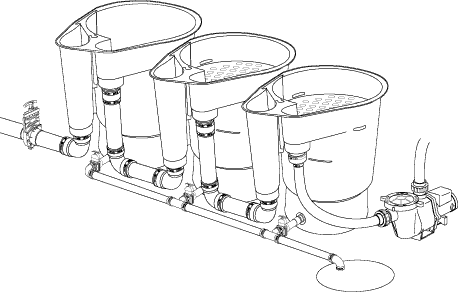 General Information
General InformationGreen Roofs
Rainwater Harvesting
Ponds and Wetlands
Systems
Liners
Filters
Pre-Filters
Gravel Filters
Waterfall Filters
Vortex Filters
Pressure Filters
Filter Media
Pumps
Plumbing
Fountains
Water Quality
Other Products
Documents
Energy-Efficient Building
Waterproofing

VORTEX FILTERS
Vortex filters offer reliable, ultra-low-maintenance filtration for ponds where significant amounts of organic matter accumulate on the bottom, such as koi ponds. Fish waste, uneaten food, leaves, and other bottom debris flow into a bottom drain, through a large-diameter pipe, and into the first chamber of the filter where a rotating vortex causes them to settle. The water then flows into a second chamber where it spins around and drops more solid matter before flowing up through biological filter media. Depending on the pond size, the same process may be repeated in a third or fourth filter chamber. An external pump draws filtered water from the final chamber and pumps it back to the pond, preferably through a UV sterilizer.
PondTechnology vortex filters are by far the most efficient vortex filter systems available today. Unlike other vortex systems, pond water enters each chamber through an intake manifold with a vertical slot that creates a thin film of water near the exterior wall of the tank, greatly enhancing solids separation. The filter media is a superior-quality, thick, reticulated-foam pad designed for optimum biological surface area with minimal resistance to water flow.

INSTALLATION: Since the four-inch inlet pipe offers very little resistance to water flow, vortex filters can be situated a considerable distance from the pond. The top of the filter chambers must be positioned just above the water level of the pond, so vortex filters are usually installed in pits made of concrete, concrete block, or treated lumber. Pit installation also protects the chambers from freezing weather. Since vortex tanks are quite heavy when filled, the bottom of the pit should be concrete or paver blocks set on very well-compacted gravel. The pit must be large enough to accommodate the filter chambers (each measures 32" x 44" x 41" high), an ultraviolet sterilizer, all necessary plumbing, and a plastic sump pit if required. Although all of our filters are supplied with lids, plumbing fittings, pipes, and valves must be ordered separately.
MAINTENANCE: Each chamber has a conical lower section with a 2" drain fitting. The drains are connected through knife valves to a pipe running into a sump well that is automatically evacuated by a sump pump. If the land slopes away from the pond, it may be possible to drain to daylight instead. The valve on each drain line should be opened briefly every week to flush accumulated solids. Every two months, debris on the filters pads should be dislodged and the pads should be flipped over.
SIZING: A vortex chamber can be used as a prefilter for bead filters, bog filters, or any other filter system. A vortex chamber with a single filter chamber will provide both prefiltration and filtration for moderately stocked koi ponds up to 5000 gallons. A vortex chamber with two filter chambers will provide both prefiltration and filtration for moderately stocked koi ponds up to 8000 gallons. In all cases, water flow rates should not exceed 3500 GPH through any chamber. If greater circulation rates are desired, additional water can be drawn from a skimmer directly into the pump, or water can flow through two parallel filter systems, each fed from a separate bottom drain.